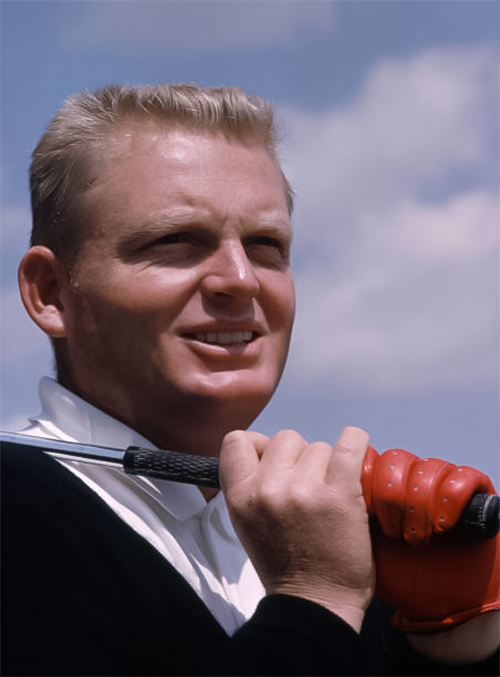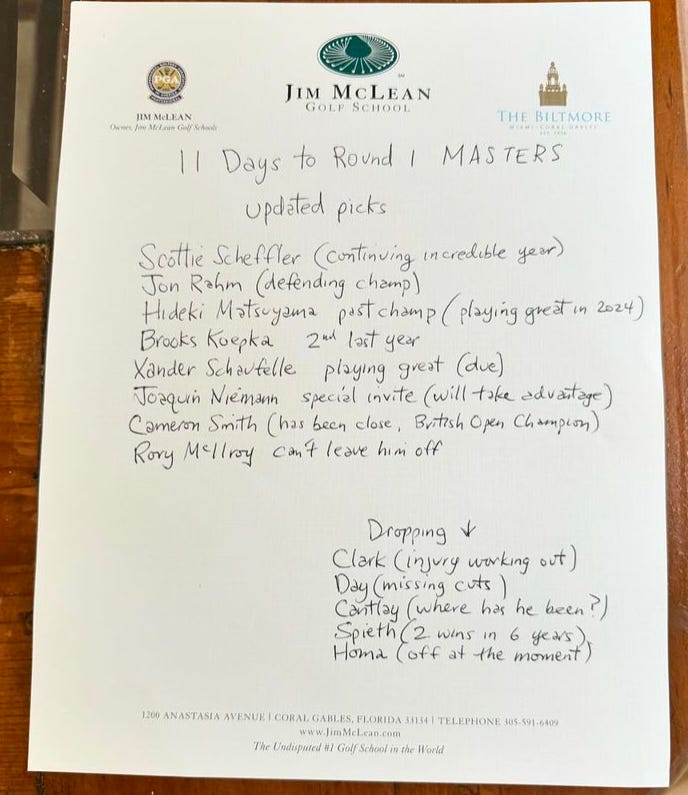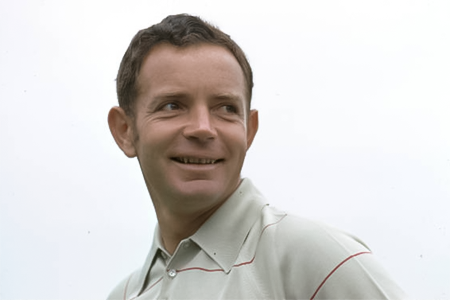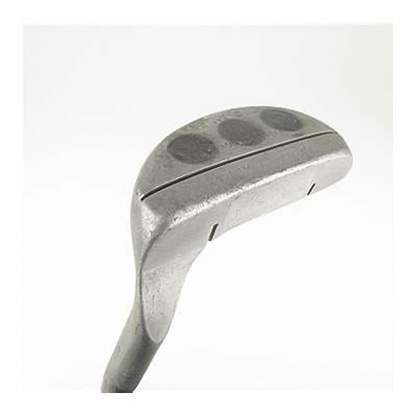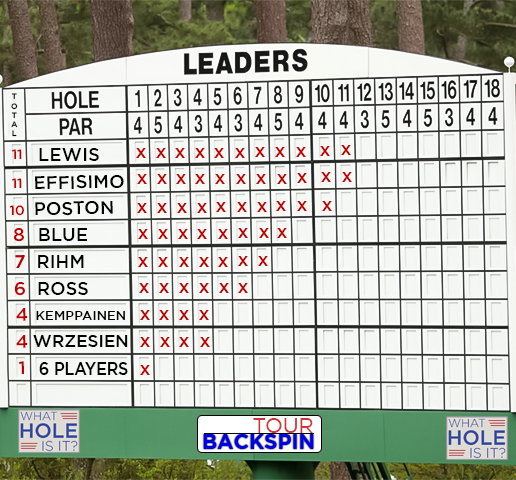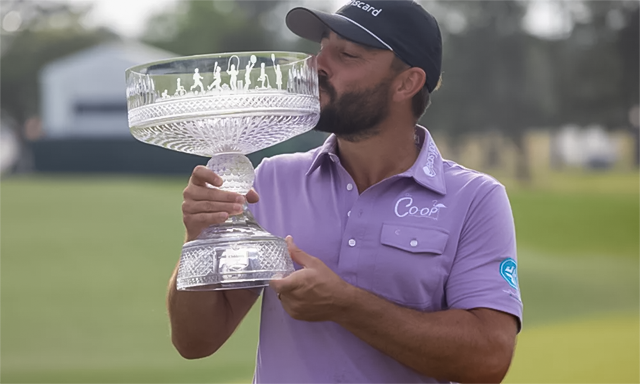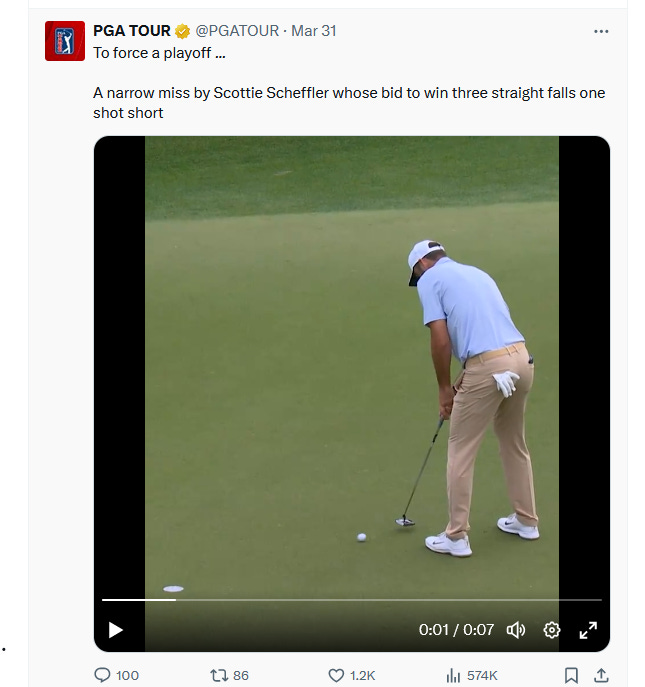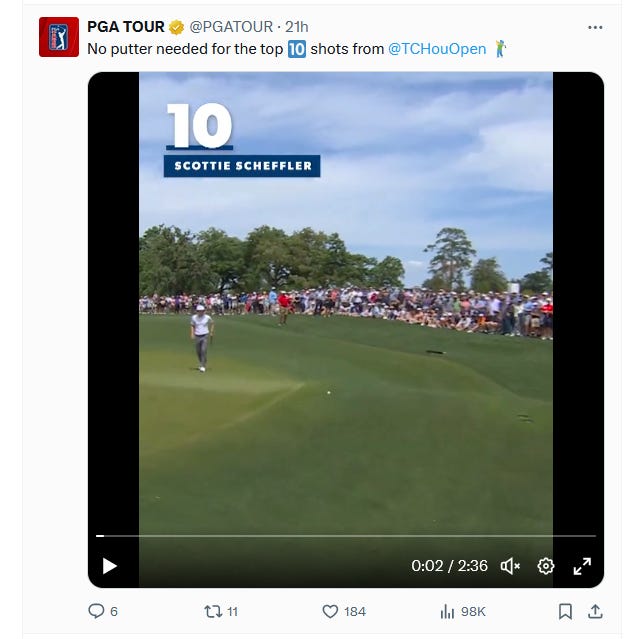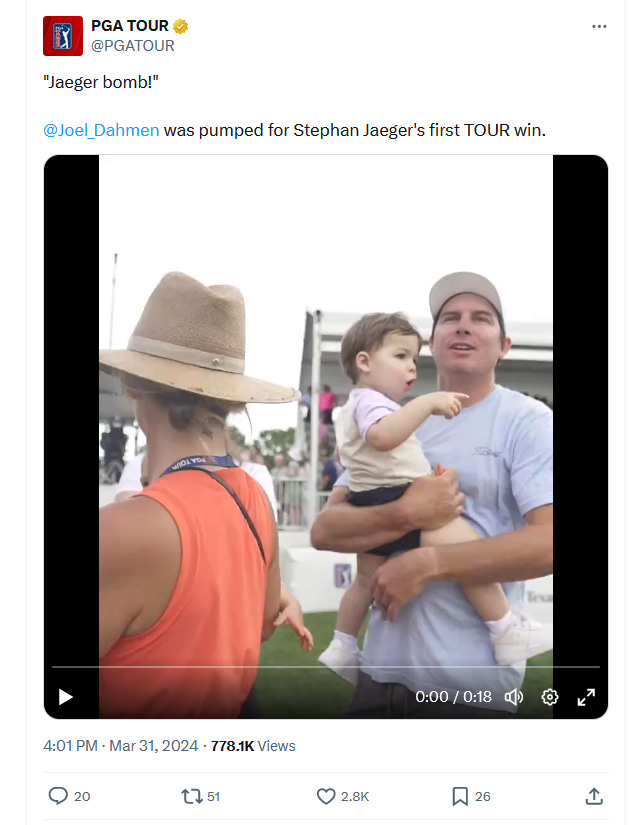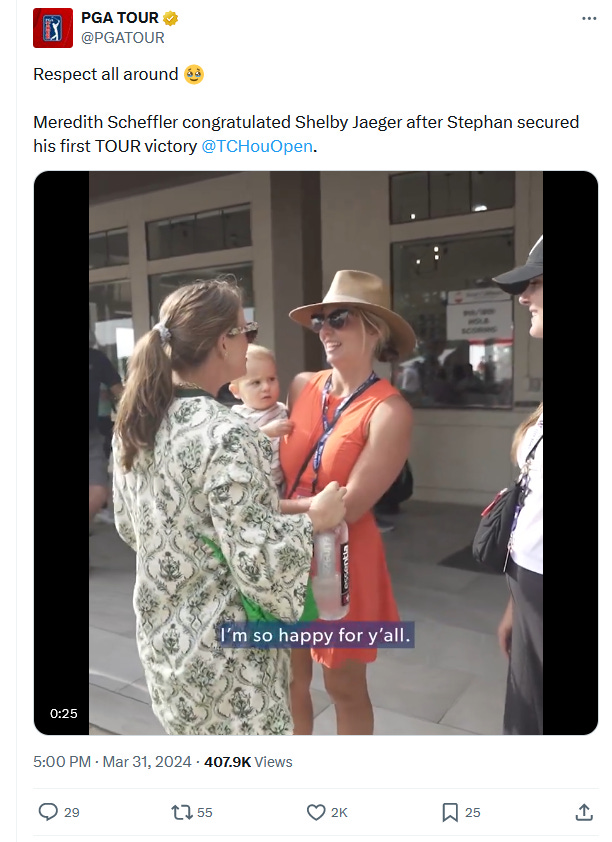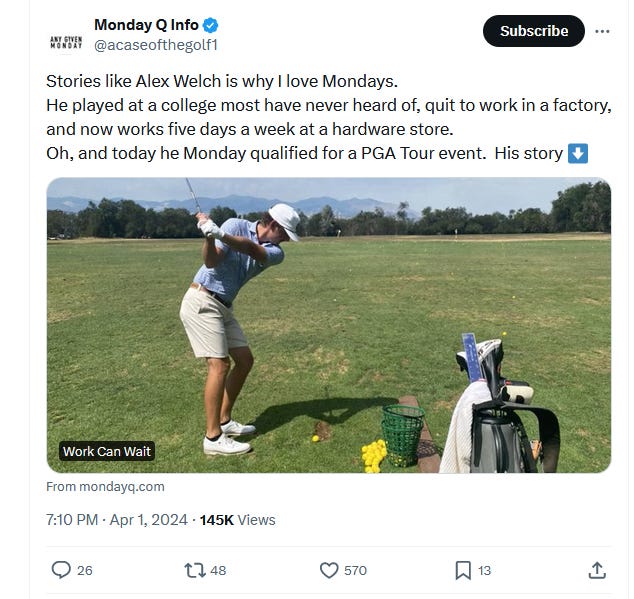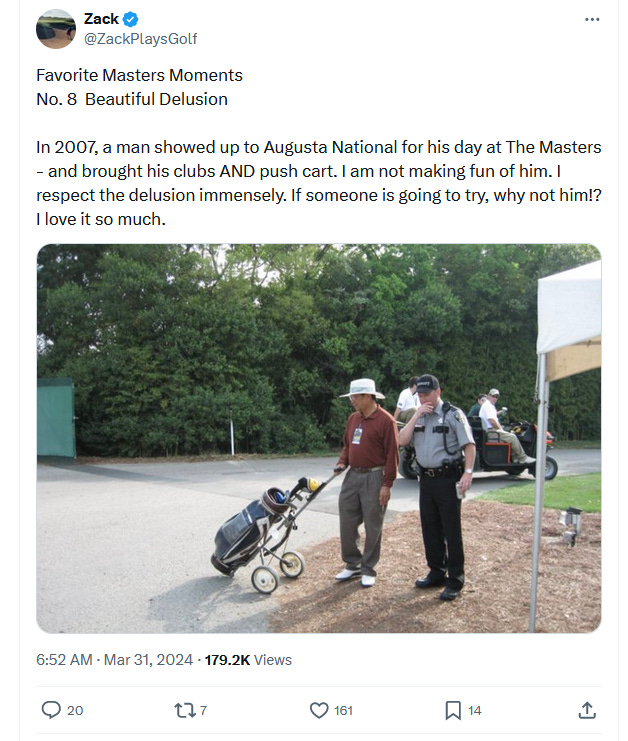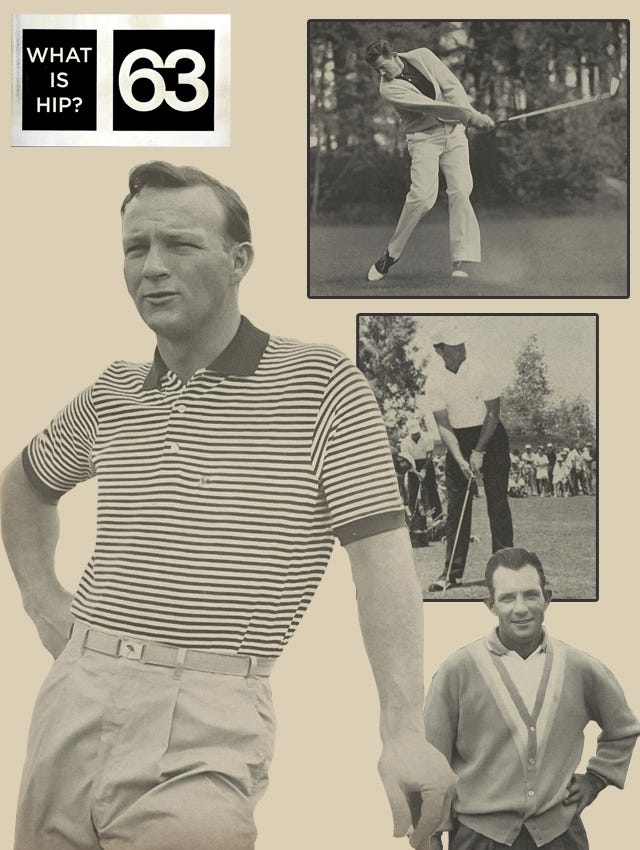"It Was a Rip-Snorter"
Phil Rodgers outduels Johnny Pott in 1963 Texas Open
Join us on our journey through the past where we travel back to 1963 and the Texas Open won by the colorful Phil Rodgers. Scroll down to learn more about how he outdueled Johnny Pott to win his third title on the PGA TOUR.
Stephan Jaeger arrived at the 72nd hole in the Texas Children’s Houston Open with a one stroke lead over six other players, including Scottie Scheffler. All faded away except for Jaeger and Scheffler. Jaeger made a par and then watched as Sheffler missed the short putt he needed to force sudden death. It was fun to watch if you could sneak away from the madness of March basketball for a spell. Scroll down for the Clips You Might Have Missed, a recap of the tournament and highlights from the week.
This week the tour remains in Texas for the LAST TOURNAMENT BEFORE THE MASTERS! The Valero Texas Open is in San Antonio at the TPC San Antonio (Oaks Course). The Texas Open dates back to 1922 when it was won by Bob MacDonald by one stroke over Cyril Walker. In 1951, Al Brosch became the first player to shoot a 60 in a PGA TOUR event during the third round at Brackenridge Park. We’re going back to 1963 when Phil Rodgers, one of the true characters of the tour, won by beating Johnny Pott. Learn how the tournament served as a coming out party for Ray Cook putters.
If you want more on the Texas Open, we covered the 1970 event, won by Ron Cerrudo HERE, and the 1976 event, won by Butch Baird, HERE.
We want to hear from you in the Tour Backspin Poll, and we’re going back to the beach for some surfing in 1963 with the Beach Boys in this week’s Music Clip. Watch the swing of Johnny Pott from the Shell’s Wonderful World of Golf archives. Take a stab at this week’s WHAT HOLE IS IT?, and of course, some links for you in the Check it Out section. I love this week’s Vintage Ad—I must have one! Scroll down to view.
Now is the perfect time to upgrade to a premium subscription to Tour Backspin. Premium subscribers get special content and early access to podcasts and videos. Save 20% on the first year of an annual subscription during our Masters Sale. Offer expires on April 19th. Click HERE to save now.
We understand if you can’t pay for a premium subscription and we’re happy to have you here however you’ve arrived. You can sign up for a free subscription so you’ll never miss the newsletter. It will arrive in your inbox every Thursday.
In last week’s Tour Backspin Poll we asked you what kind of putter you use, blade or mallet (check out this week’s Bonus Fact about one of the most popular mallet-head putters in the 1960s). There were 67% of you who use a blade putter, going old school, while 33% of you think you need the help that a mallet provides.
It’s time to make your Masters picks! Here’s what friend of Tour Backspin, Jim McLean predicts:
Be sure to check out Jim, and Craig Welty on The Tour Backspin Show podcast where they talk about Craig’s father, Carl Welty. You can listen HERE.
For this week’s poll, let’s see if you agree with Jim and his top pick of Scottie Scheffler, or if you think you can beat that pick. All odds are from golf betting and fantasy expert Sia Nejad and CBS Sports. Pick the winner in this week’s Tour Backspin Poll.
Tour Backspin Poll
Do you know what happened today in golf history? Or which famous golfer has a birthday today? Me, neither. But I do know where to go to find out. Check out the Your Golfer’s Almanac podcast. Host Michael Duranko celebrates birthdays, milestones, and other accomplishments that occurred on this day in golf history. Listen HERE.
We’re playing Texas Open Trivia in this week’s Tour Backspin Quiz. Scroll down to play.
Did you miss a previous newsletter? You can view it HERE. Help us grow Tour Backspin! Please forward this email to a friend. Was this newsletter forwarded to you? You can sign up HERE.
Okay, we're on the tee, let's get going.
Enjoy!
Larry Baush
Phil Rodgers Holds Off Johnny Pott to Win Texas Open
Excitement is in the air on the evening of Tuesday, April 23rd, 1963, as a well-dressed crowd arrives at the Oak Hills Country Club located about 10 miles northwest of San Antonio. The San Antonio Golf Association is honoring Arnold Palmer, the three-time defending champion of the Texas Open, with a dinner on the eve of the pro-am that opens the tournament.
Palmer was heavily favored to win the $30,000 Texas Open for the fourth consecutive year, and his practice round 68 on Tuesday, before the dinner in his honor, only elevated expectations. His 65 in Wednesday’s pro-am, tying him with Johnny Pott for first place, was the fourth time, in a row, that he’d won the pro-am at the Texas Open. They were almost putting his name on the trophy and filling in the “pay to the order of” line on winner’s check before the first tee shot was even airborne.
“This putter has perfect geometric and dynamic balance.”
Before his pro-am round, Palmer was approached by Ray Cook, a local San Antonio inventor and club designer, who gave Palmer a mallet-headed putter with the name VI-BRA-GROOV. The putter was entirely a San Antonio product as it was milled by the local company, Dobbins Machine Works. The distinguishing feature of the putter was a groove that ran parallel to the face, and ½” behind the face, that provided a floating face which directed the vibrations from striking the ball up the shaft and into the hands for a better feel. Cook was inspired by a tuning fork to come up with the idea.
“This putter has perfect geometric and dynamic balance,” Cook told a reporter from the San Antonio Light paper on Wednesday. “I’ve worked on this, off and on, for eight years, and now I’m working on a pitching wedge and driver based on the same principal.”
Cook also gave models of the putter to Doug Ford, Jacky Cupit, Mike Souchak, and Mason Rudoph. Johnny Pott also received one and used it, for the first time ever, on the first green of the pro-am. He then had one of his best putting days, ever. He had only 26 putts on his way to his 65. Palmer said he would have used the putter but wanted to put a new grip on it first.
Palmer began his quest for a fourth straight title at 12:12 on Thursday playing with Al Balding and Doug Sanders. There were 56 players who bettered par on the 6,775-yard, par-71 Oak Hills course, and Palmer wasn’t one of them. He could do no better than an even par 71.
It was a 27-year-old bachelor from Australia, Bruce Crampton, who enjoyed a two-stroke lead after a first round 64. Crampton had seven birdies, an eagle, and two bogeys in his round. The eagle came on the 535-yard, par-5, 10th hole after he drove into the woods. He spotted an opening in the trees and hit a 6-iron to within four feet of the cup and then made the putt.
In fact, there were 14 eagles scored in the first round. Phil Rodgers, Tommy Aaron, Johnny Pott, and Don January were two shots back of Crampton, at 66, and all four players had eagles of their own during the round. Aaron and January made long putts on the 550-yard, par-5, 15th hole, while Pott made a 10-footer at the 10th hole for his eagle. Rodgers holed out from 135-yards for a deuce at the par-4 6th hole.
Pott used his new Ray Cook putter again in the first round. He had two three-putt greens on his way to his 66.
Crampton’s day included a double-bogey on the 12th hole and a four-over-par snowman eight on the 17th hole.
The wind came up for Friday’s second round and the course played much tougher than it did on Thursday. Only 32 players were able to break par and the cut came at 144, 2-over-par with 76 pros making the cut. Crampton had an eventful day on his way to a 72 and a total of 136. He was able to retain a share of the lead and was tied with five other players—January, who had a second round 70, left-handed Bob Charles, who added a 67 to his first round 69, Aaron, who came in with a 70, Frank Beard, with a second straight 68, and former U.S. Open champion, Jack Fleck, who had the best round of the day, a 67.
Crampton’s day included a double-bogey on the 12th hole and a four-over-par snowman eight on the 17th hole. His adventure on the 17th hole included a ruling decision that went against him concerning television cables. Unhappy with the ruling, he followed up by hitting a pitch shot that struck a rock and ricocheted out of bounds.
“A switch from contact lenses to regular glasses, after two bad weeks when I wore no glasses at all, made a big difference in my game.”
One stroke back of the leaders, at 167, were Rodgers with a 71, Pott who also had a 71, and Miller Barber who shot a 70 to go with his first round 67.
Beard, a 24-year-old from Louisville, KY, had been on the tour only since November and he credited a change in eye wear for his good play.
“A switch from contact lenses to regular glasses, after two bad weeks when I wore no glasses at all, made a big difference in my game,” Beard said.
Palmer played better on Friday and hinted that he was going to mount one of his famous charges. He improved to a 68 and was lurking just three strokes off the lead.
If Friday was the day that the leader board became crowded at the top with 20 players within two strokes of each other, then Saturday’s round was for distilling the leaders down to just four players within two shots of each other at the top.
Both Rodgers and Pott pulled away from the pack with third round 66s that gave them a 203 three round total. They enjoyed a two-stroke lead over Crampton who had a 69, and Bobby Nichols, who shot the round of the day, a 65.
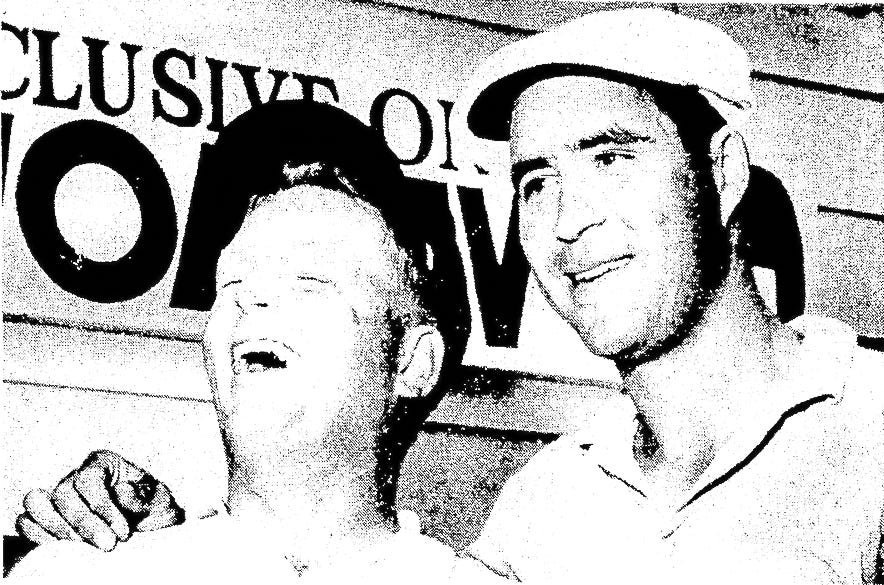
Doug Sanders had a good day with a round of 66 for a total of 206 and he was tied with Fleck (70), Barber (69), Jerry Steelsmith, who had rounds of 68, 70, and 68, and Henry Ransom with rounds of 68, 71, and 67.
“I’ve been finishing flat on my swing. But Henry got me back on the beam. He’s a great teacher. I ought to talk to him every day before starting a round.”
Nichols went to Texas A&M on a football scholarship because the school did not offer golf scholarships and Bear Bryant, the football coach, wanted Nichols to play for the golf team. His golf coach was the same Henry Ransom that was just one shot behind him after three rounds. Nichols credited Ransom for a lesson that he received from his former coach on Friday.
“I’ve been finishing flat on my swing,” Nichols told reporters after his round. “But Henry got me back on the beam. He’s a great teacher. I ought to talk to him every day before starting a round.”
“I’m putting better this week than I ever have before.”
Pott rifled his iron shots close to the pin and then made just about everything with his new putter.
“I’m putting better this week than I ever have before,” he admitted to Bob Ostrum of the San Antonio Light newspaper after his round.
For his part, Rodgers was extremely happy with his play.
“I played as hard as I can,” Rodgers told Ostrum.
Palmer looked like he was mounting one of his patented charges as he made the turn four-under-par for the day and tied with both Crampton and Rodgers. He then had three straight bogeys to start the back nine and then topped that off with a double bogey on the 13th hole. He managed a couple of birdies coming home to post a 70 but he was six strokes off the lead. His chances for a fourth consecutive Texas Open victory had slipped away.
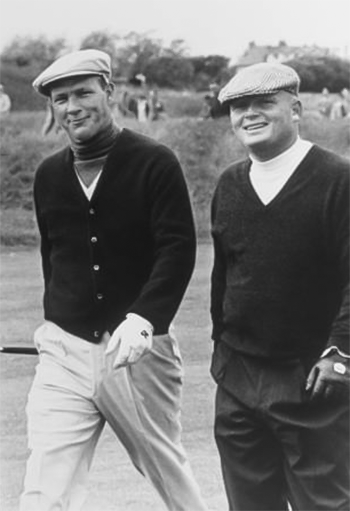
The weather forecast for Sunday’s final round was for scattered afternoon showers and temperatures in the 80s under mostly cloudy skies and a slight wind. Rodgers was in the penultimate group at 12:30 playing with Crampton and Ransom. Pott was in the final group at 12:40 playing with Nichols and Fleck. It quickly became a two-man race between Rodgers and Pott.
He held the lead through the 15th hole, a hole both players birdied.
Pott got off to a hot start with a birdie on the first hole but handed the shot right back when he flew the second green and made bogey. Rogers lost a stroke to par on the 3rd hole when his approach came up short and in a bunker, but he came right back with a birdie on the 4th after sinking a 12-foot putt. Pott answered with a birdie of his own on the fifth to regain a one-stroke lead.
Both players birdied the eighth hole and then Rodgers added another birdie at the 9th hole and both players made the turn in 33 strokes. The two players birdied the 10th hole before Rodgers pulled ahead with a birdie on the 12th hole. He held the lead through the 15th hole, a hole both players birdied.
“He hit over the green! How about that?!”
By this time, the Rodgers group had pulled out ahead of the final group and Rodgers birdied the 17th hole, with a putt from 18 feet, and then he secured a par on the finishing hole, a par-3, before Pott was ready to putt on the 16th hole. With a round of 65, and a total of 268, Rodgers headed to the locker room to follow Pott’s finish. He no sooner got to the locker room when he heard a roar from the television in the adjacent grillroom and knew that Pott had made birdie on the 16th hole.
He grabbed an iced, non-alcoholic drink and nervously paced the locker room. He peeked back into the grillroom just in time to see Pott hit his approach shot on the 17th over the green on the television.
“He hit over the green!” Rodgers exclaimed to no one in particular. “How about that?!”
His caddie approached him and asked, “How about a beer?”
“No, we may have to go to the post yet,” Rodgers replied still thinking that a playoff was possible.
They both watched as Pott made a fine chip, up to within a couple of feet. Then the Ray Cook putter, that he had wielded so well all week, let him down as he missed the short putt. He would now need an ace at the final hole to tie Rodgers. When that didn’t happen, Pott had to settle for the $3,000 second-place money.
“It was a rip-snorter. I’m all shook up. I’m not used to this.”
After John Monfrey, president of the San Antonio Golf Association, handed Rodgers the $4,300 winner’s check Rodgers said a few words.
“It was a rip-snorter,” Rodgers said before stammering over his next words and saying, “I’m all shook up. I’m not used to this.”
“We left a few dollars in Vegas the last time we were there. We have to hurry to get it back before the tournament starts.”
Most of the late finishing pros were in a hurry to depart the grounds and catch flights to the next stop on the tour, the Tournament of Champions in Las Vegas. Rodgers wasn’t one of them as winning the Texas Open qualified him for the next year’s Tournament of Champions. But Pott was headed to Las Vegas and cut short his second-place acceptance speech.
“We left a few dollars in Vegas the last time we were there,” he explained. “We have to hurry to get it back before the tournament starts.”
Or was he just excited to use his new Ray Cook putter in another tournament?
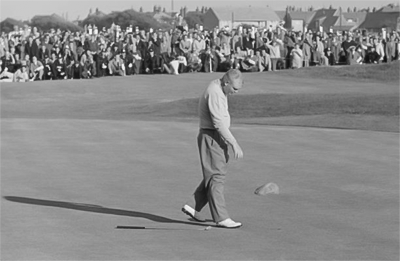
Follow us on Facebook, Instagram, Twitter, YouTube and Threads.
BONUS STORY
Ray Cook’s VI—BRA—GROOV putter, the same model that he gave to Johnny Pott and Arnold Palmer at the 1963 Texas Open, hit the general market in April of 1964. Cook used seeding in the Texas Open to get validation for his putter design by the players on the PGA TOUR. In addition to a free putter, these players were also offered a monetary bonus to any winning player who had only the VI—BRA—GROOV putter as the putter in his bag for the final round.
“Cook’s VI—BRA-GROOV putters now win more money on the PGA Tour and in other parts of the world than any other weapon used on the greens.”
Cook’s bonus started at $1,000 but it wasn’t long before he increased the bonus to $5,000 for first place and lesser amounts for second and third place. It didn’t take long before he had a stable full of pros using his putters including Billy Casper and Bruce Crampton.
By 1966 the company was touting that, “Cook’s VI—BRA-GROOV putters now win more money on the PGA Tour and in other parts of the world than any other weapon used on the greens.” And the wins were stacking up; Roberto Di Vincenzo at the 1967 Open Championship, Orville Moody in the 1969 U.S. Open, Bruce Crampton at the Colonial Invitational in 1965, the1968 Colonial Invitational won by Billy Casper, Bruce Crampton winner of the Texas Open in 1964, and Orville Moody in the World Series of Golf in 1969.
By 1973 Ray Cook putters had won 135 major events around the world and was the number 1 selling mallet-head putter on the market. The Hogan Company even asked Cook to design putters for their club line.
In 1974, at the height of his business, Cook sold the company to long-time friend Bob Olson. Cook continued to design and sell the putters while Olson handled the manufacturing end of the business. In 1979, Olson and his partner, Jim Braun sold the Ray Cook Putter Company to Bob Coleman. Coleman divulged that the lack of international patents on the original designs were hampering the growth of the company, and it was finally auctioned off in June of 2010.
(h/t: B.C. Golf House Society)
The Tour Backspin Show with our guests Jim McLean and Craig Welty has been unlocked for all subscribers. Want to get podcasts two weeks early? Upgrade to a premium subscription today to listen early. We talk about Craig’s dad, Carl Welty, and about how he used video to study the golf swing. Listen HERE.
Listen to The Tour Backspin Show podcast on Substack with the above links, or on Spotify, Apple Podcasts, or iHeart Radio.
WHAT HOLE IS IT?
Are you on the leader board?
Congratulations to Glenn Blue who correctly identified #18 at The Woodlands Country Club in The Woodlands, TX, in last week’s WHAT HOLE IS IT? contest. Glen beat out two other correct answers in the random drawing and a new golf polo is on its way to him. Submit your answer for this week and get yourself into the race for the Herbert C. Leeds Trophy, our new perpetual trophy for the annual winner.
PGA TOUR Wrap-Up | Texas Children’s Houston Open
A great, tight finish at the Texas Children’s Houston Open where Stephan Jaeger teed off on the 72nd hole with a one shot lead over six other players, including OWGR #1, Scottie Scheffler. Jaeger made a par and then stood by while Scheffler faced a five-footer he needed to make to tie and force a sudden death playoff. Scheffler missed and Jaeger had his first win on the PGA TOUR in 135 starts.
The 34-year-old German took home $1,638,000 and 500 FedEx points, but also earned his way into the Masters and has the upper hand in earning a spot in the Olympics.
Read a full recap of the event, by Cameron Jourdan in Golfweek HERE.
Check out the top ten shots from the week via the PGA TOUR:
Clips You Might Have Missed
Joel Dahmen knows how to celebrate for a friend—even if it means stepping in front of the friend’s wife.
Speaking of the wives on tour, this was touching.
Malnati ace!
This is so cool. See ya in San Antonio, Alex.
A lot of narcs in Idaho.
He’s ready. Are you?
Don’t miss our Masters Sale to upgrade to a premium subscription with the first year of the annual subscription 20% off. Get the deets HERE.
Tour Backspin Quiz | Valero Texas Open Trivia
Who set the 72-hole scoring record on the PGA TOUR in 1955 at the Texas Open? What was his score relative to par? What did he shoot? How long did those two records stand and who broke them?
Scroll down for answer
Swing Like a Pro
Johnny Pott’s swing in 1965 from Shell’s Wonderful World of Golf
Blind Shot
Click for something fun. 👀
Mathew Rudy shows us what might be on the horizon if LIV Golf and the PGA TOUR merge by taking us back to see how other sports league handled merger. From Golf Digest.
Brandel Chamblee has a lot to say to Golfweek’s Adam Schupak.
Josh Berhow writes in Golf.com about what we learned from the LIV Golf teaser with Anthony Kim answering questions from David Feherty.
Tour Backspin Music Clip
Let’s go to the beach!
Uncorked, The Life and Times of Champagne Tony Lema tells the story of one of the tour’s biggest stars in the mid-1960s. A fascinating glimpse into the traveling caravan that was the PGA TOUR during an era where the fields were full of “Mad Men” era personalities. From a hardscrabble youth spent on the “wrong side of the tracks” in the Oakland suburb of San Leandro, to the temptations of Elko, Nevada, to the bright lights of the PGA TOUR, Uncorked tells a story of determination, redemption and, above all else, a love story that documents how Betty, Tony’s new wife, provided the direction and motivation for him to become a top star. Order on Amazon.
WHAT IS HIP?
What the tour pros wore in 1963. Clockwise from left, Arnold Palmer, Doug Sanders Bobby Nichols, and Jay Hebert. (Photos: Golf Digest/ Image Tour Backspin)
WE GOT MAIL
GREAT title.
Brad F. on the title of the March 28th Tour Backspin newsletter (Strange Win).
Send us your thoughts.
Tour Backspin Quiz Answer:
Mike Souchak shot a 72-hole score of 257, which was 27-under-par, in 1955. The under par record stood until John Huston shot a 28-under-par 260 in the 1998 Hawaiian Open. The scoring record lasted until 2001 when Mark Calcavecchia broke it with a 72-hole score of 256 (-28) at the Phoenix Open.
Thank you for reading this far, I know your time is valuable and choosing to spend some of it on what I’ve created is gratifying. If you want to help support the work we’re doing, please consider upgrading. It’s just $36 a year (20% off your first year with our Masters Sale—expires April 19th) and you’ll be helping to tell the stories from one of golf’s golden ages.
Vintage Ad
Final Thoughts
Phil Rodgers sure looks like he would be a fun guy to hang out with.
That was a sweet scene between Meredith Scheffler and Shelby Jaeger after Stephan Jaeger won the Texas Children’s Houston Open.
I have to have that golf table game! No C.O.D.s please. Remember C.O.D.s?



